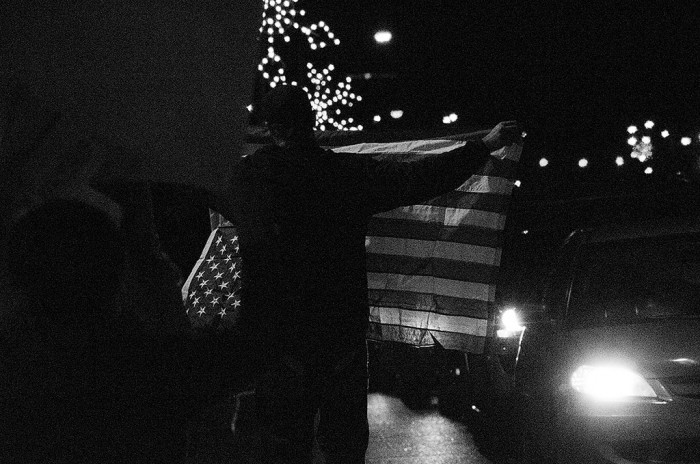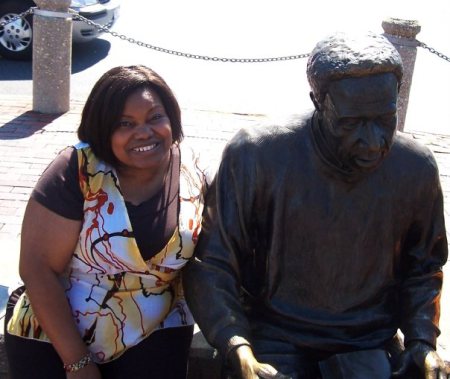
Tracie Powell tries not to use the word “diversity” anymore.
“When you talk about diversity, people’s eyes glaze over,” Powell, the founder of All Digitocracy, told me. The site covers tech, policy, and the impact of media on communities that Powell describes as “emerging audiences” — people of color and of different sexual orientations and gender identities.
 I first heard Powell speak at the LION conference for hyperlocal publishers in Chicago earlier this month, where she stood in front of the almost entirely white audience to discuss how journalists and news organizations can get better at reporting for more people.
I first heard Powell speak at the LION conference for hyperlocal publishers in Chicago earlier this month, where she stood in front of the almost entirely white audience to discuss how journalists and news organizations can get better at reporting for more people.
I followed up with Powell, who is currently a John S. Knight Journalism Fellow at Stanford, to hear more. “If we [as journalists] don’t do a better job at engaging with these audiences, we’re dead,” Powell said. “Our survival depends on reaching these emerging audiences.”
Here’s a lightly condensed and edited version of our conversation.
I started off on the business side of newspapers and then switched over to the newsroom when I saw circulation going down. I felt that maybe, if I could get some of those stories in the newspapers that people could really relate to, then they would start subscribing and buying the paper more. Journalism was always my first love, anyway. I thought I could have a bigger impact by being in the newsroom.
It turned out not to always be true. I wasn’t an editor; I wasn’t making the decisions on what we covered and didn’t cover. This is all background to say that this isn’t a new problem.
My parents always wanted me to go to law school, so when I thought about leaving journalism it was kind of the first place I turned to, to see if this was something I actually wanted to do. I enjoyed it, but I knew pretty quickly that I didn’t want to practice law, and so I started looking at classes that related to journalism. I never really stopped being a journalist. I knew that I would probably need to apply what I was learning there to what I was doing in journalism.
I started writing my own blog, TMP Unplugged, because I was like, well, maybe if I start writing about it for myself, it’ll make sense to me, and hopefully it’ll start making sense to other people. I wrote about all kinds of policy issues and followed hearings. People started paying attention, actually — following me, retweeting some of the stuff I wrote, aggregating or referencing it in their stuff — and I was shocked. I was like: See, I knew that people cared about this stuff! It was a confirmation for me that all of this stuff fit, in some way: law, media, journalism, policy. All this stuff came together.
When people started following TMP Unplugged, I saw that there was an opportunity here to do more, and I made up my mind. Two years ago in August, I made up my mind to take it to the next level, and it became All Digitocracy.
Right now, I’m at Stanford and what I’m working on is that diversity is no longer cool. When you talk about diversity, people’s eyes glaze over. When I gave you my elevator pitch, I didn’t even mention the term diversity. People don’t want to talk about it.
[All of our writers] are contract right now. I have a couple of editors; I’m looking for a development consultant.
We were able to get a couple of grants; I did a crowdfunding campaign. NerdWallet.com is now an underwriter of a journalism web series we’re producing. I’ve been spending my time lately trying to raise money for the company, which was the point of hiring an editor [Benét J. Wilson] to take over.
I’m trying to figure out how to underscore how important it is. If we [as journalists] don’t do a better job at engaging with these audiences, we’re dead. Our survival depends on reaching these emerging audiences. If the mainstream media, if the daily newspapers are not going to do it, then the hyperlocals have an opportunity. Even though they don’t have that much money, we should reach out and partner with ethnic media publications in our communities to broaden our coverage.
We have the people in power covered. It’s the folks who don’t have the power that we tend to ignore, not think about, or look over.
There was the whole #pointergate fiasco. Instead of the TV station reporter going out and actually doing his homework, he relied on what police told him. And what police told him could have very well gotten the young man in the picture killed. He accused that young man of being in a gang.
I don’t know what you know about gang culture, but if you go around pretending that you’re a member of a gang and you’re not, you’re asking to be killed. This so-called journalist put this young man’s life in danger by saying he was in a gang, which was inaccurate. Then he took to Twitter, calling the young man a thug. That’s biased journalism on top of erroneous reporting. Even after he was shown where he was wrong, the reporter continued to push this story about this young man being a thug and a gang member.
There’s too much of that; there are too many examples to point out of bad journalism that erodes the trust and credibility of our profession.
Another New York Times example is the Alessandra Stanley piece about Viola Davis being “less classically beautiful” [than other, lighter-skinned actresses]. There’s no way that an editor who shares my experience as an African-American woman would have looked at that story and let it go.
It was pretty unforgivable. The article that Stanley wrote was hurtful, it was disrespectful, it was bad journalism, and it was so ignorant. It showed that we as journalists have no clue about some of the people that we write about. And then Alessandra was put in a position to cover income inequality. And that was approved by a black editor.
The decisions that we make in terms of coverage and staffing speak volumes to audiences. If you ever wonder why news organizations have problems engaging with emerging audiences, just look at some of these examples.
I was at ONA a couple of weeks ago, and I remember hearing an editor, a very high-profile editor, say he hires for “fit and personality.” Well, I think that’s part of the problem. These editors keep hiring people who quote-unquote “fit.” We need to start hiring some misfits so that they can bring a fresh perspective to our coverage.
That editor probably meant he wanted to hire people who got along with everybody else. We don’t have to like each other. We can value a difference of opinion; we can value differences and still enjoy working with each other, be respectful and professional in the workplace.
When editors say, you know, “I hire for fit,” they’re automatically sending a red flag to job candidates, particularly women and people of color, because we’ve never fit. I’ve worked in places where I was the only person of color. At that conference in Chicago, there were two people of color in that whole conference; I was the only black person. We’ve always stood out.
That’s the No. 1 solution, hiring. Another solution might have been social media. Usually we write about what’s happening on social media as a reaction to whatever controversy du jour has happened. We should go beneath the surface and try to start reporting out some of the nuances that folks discuss on social media. Even though Twitter restricts people to a certain number of characters right now, there are some really deep conversations that happen on Twitter if you read between the tweets and if you read all of the tweets. That’s what I meant about following social media.
I also talked about partnerships. We’re so busy trying to partner with Vice and BuzzFeed and all these other places, but how about partnering with some of the ethnic media publications? Even though they struggle mightily, they have loyal audiences.
We also need to partner with them so that we can deepen our coverage.
[Fusion parent company Univision] recently bought TheRoot.com from The Washington Post. Their recent collaboration was a documentary about the school-to-prison pipeline. I thought that was good. We published a piece about that as well.
Now, where I think Fusion could do a better job: Fusion hires a lot of young people on its staff. There’s nothing wrong with that. But I believe it completely dismisses more experienced journalists, mid-career journalists, who understand digital and can offer vision.
Fusion needs to shore up its vision or to help people understand what its vision is. I think some more experienced journalists could help in that respect.
I saw a piece yesterday, I think it was a letter to the editor about Black Lives Matter inconveniencing other people on their way home from work. “Black Lives Matter’s protestors were a major inconvenience holding up traffic, blah, blah.” People don’t understand: This is the only way these young people thought that they could get the attention of mainstream white America.
As journalists, that’s one of our main jobs: We’re supposed to challenge power. And it seems like we’ve abdicated that to social media.
As long as journalists don’t do our jobs, we’ll have to turn to Black Twitter and these other sites that we talked about earlier to get an understanding. Unfortunately, the writer of that op-ed piece is not going to turn to Black Twitter or Latino Rebels. But he or she might open their daily newspaper. And it would be nice if our daily newspaper explained what was really happening and why it was really happening.
Right now, we report stories on the poor and on homelessness from a perch way up high somewhere. We need to get off that perch and really try to understand, try to walk in the other person’s shoes, live as they live, breathe as they breathe, see as they see. I think that would bring provide much more interesting storytelling, if we did that.
I’m not sure that’s really happening at The Marshall Project. I don’t think they have the same amount of depth that I’m looking for, at least, on crime and criminal justice. We’ll see, though.
That’s what we’re seeing more of these days: Journalists leaving, like Akoto and Marisol, and me, and they’re going to focus on these single issues that are undercovered or not covered at all.
It turned out that all the drug charges were trumped up. The undercover investigator or the informant, a white male, lied about all of these people.
Before the story broke, I fought like hell to try to get that story in the newspaper. The editors just weren’t interested. But when the ACLU started reporting on the story themselves, trying to get a newspaper to cover it, then the story just went wild after that. People started reporting it and carrying it and sending their reporters out there. I don’t think my newspaper ever did. Those kinds of stories just, for whatever reason, editors traditionally have not been very interested in, and have been reticent to cover these communities, and some of the things that they grapple with.
Newsrooms have been struggling with this for many, many years, and if journalists are finally given an opportunity to cover the issues that they’re really passionate about — and that I believe people really care about, especially in the communities that have typically been ignored — then I applaud them.